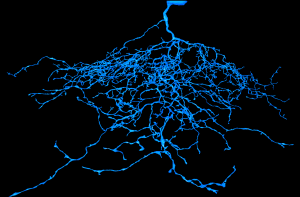EyeWire’s J Day: The Official Launch
EyeWire launches today with J Day!
It’s time to mobilize a global community of citizen neuroscientists to trace the 3D structure of J Cells and understand how retinal connectomes relate to visual perception.
 A specific type of retinal neurons called J Cells respond to stimuli that move downward on the retina (which is the same as upward in the visual world). Neuroscientists do not currently understand how the neural circuits of the retina cause the J Cell to respond in this way. That’s one of the reasons we built EyeWire. By playing EyeWire, you map the 3D structure of retinal neurons and their connections, and collaborate with neuroscientists at MIT, the Max Planck Institute for Medical Research, and Harvard.
A specific type of retinal neurons called J Cells respond to stimuli that move downward on the retina (which is the same as upward in the visual world). Neuroscientists do not currently understand how the neural circuits of the retina cause the J Cell to respond in this way. That’s one of the reasons we built EyeWire. By playing EyeWire, you map the 3D structure of retinal neurons and their connections, and collaborate with neuroscientists at MIT, the Max Planck Institute for Medical Research, and Harvard.
Over the past several months, members of Sebastian Seung’s lab at MIT have been hard at work making sure EyeWire allows users to accurately contribute to research. During our beta period, an average of 30 to 50 people played EyeWire each day. Collectively, EyeWirers have mapped over 160,000 individual cubes since the beta went live in spring. We hope to dwarf these numbers in the coming months.
Below check out a short video from Sebastian Seung, who shares why we created EyeWire and how you can get involved.